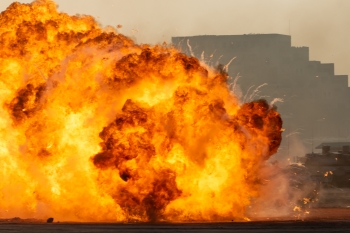On 23 February, an expert panel discussed the policies and practices for the protection of civilians from the reverberating effects of explosive weapons. This virtual roundtable was organized by the United Nations Institute for Disarmament Research (UNIDIR) within the framework of the Conventional Arms Programme. The purpose of the event was to launch a vital new tool: the Second Menu of Indicators to Measure the Reverberating Effects on Civilians from the Use of Explosive Weapons in Populated Areas (EWIPA).
This tool is built on the First menu of Indicators for a two-fold purpose. Firstly, the Second Menu was produced to offer updated research observations and considerations compared to the first one; secondly, it adds new focus areas consistent with the Sustainable Development Goals (SDGs) 6, 2, 15 and 1 of the UN. Accordingly, the quantitative indicators are set to measure some of the reverberating effects on the following sectors: water, sanitation and health (WASH), food security, environmental degradation, and economic opportunities.
The discussion was opened by the Head of the Conventional Arms Control and CSBM Division of the German Federal Foreign Office, Albrecht von Wittke. He drew attention to the use of indicators and the lessons learned from this practice. The German Government has confirmed its support for the Political Declaration on this topic in its most recent Coalition Agreement. Von Wittke pointed out two aspects of explosive weapons. Firstly, the lack of compliance with IHL rules is the primary cause of civilian casualties. Thus, since the involvement of Germany in the disarmament discussion, the Government has found it crucial to implement follow-up mechanisms to effectively protect civilians from explosive weapons. Secondly, the effects of weapons spread out over space and time with long-term consequences for civilian wellbeing and survival. In other words, von Wittke emphasized the importance of not looking only at the immediate effects, but also the reverberating effects, which have yet to be fully understood. Accordingly, improvement can only be achieved through the development of knowledge and good military practices.
After his intervention, the Deputy Director of the Disarmament and Non-Proliferation Section of the Department of Foreign Affairs, John Forde, made his statements. Forde, acknowledging the disproportionate humanitarian impact and the indiscriminate effects, stated that the Second Menu draws attention to “the devastating reality which intersects and interacts by capturing the reverberating effects” to allow parties in conflicts and stakeholders to have a broader understanding.
At this stage, the screen was given to the co-authors of the Second Menu of Indicators, Alfredo Malaret and Francesca Batault. Malaret, claiming that the Second Menu is “a tool in the toolbox […] from which you can choose and get ideas”, presented how these reverberating effects can be systematically documented and measured. It covers four areas only because it is a sophisticated system measuring progress and indicating “if something gets worse”. The expert noted that some indicators must be adapted to the context to be effective. Therefore, he went on to mention that the use of a research consideration based on a three-level structure (1. damage and destruction, 2. change and costs, 3. civilians wellbeing) is crucial to show the sequence of how explosive weapons can lead to reverberating effects. Following Malaret’s intervention, Batault carried out the discussion on the focus areas and provided some guidance on indicators. In order to illustrate, the denial of access to WASH is particularly detrimental to children due to a lack of sanitation. Moreover, as food security is essential for people's survival and their productive life, the destruction of agriculture leads society into insecurity, disease and malnutrition. Furthermore, armed conflict effects also lead to environmental degradation such as the spread of chemicals and heavy metals, which endanger the lives of people. Finally, economic growth is also affected because the lack of economic opportunities jeopardizes the stabilization of society. In short, she claimed, “these focus areas show that the use of excessive weapons in populated areas has complex reverberating effects on societies and individuals”.
These points were taken up by Laura Boillot, the Coordinator of the International Network on Explosive Weapons, who further drew attention to the “widespread pattern” these weapons cause in the focus areas. The main focus of her discussion is the interconnection of services and infrastructures, underscoring the domino effect created by reverberant effects. As attacks cause services to go haywire, damage and destruction instantly debilitate the lives of civilians. Hence, Boillot’s core issue aims to create awareness about the need for the anticipation of effects to make the impact of such weapons preventable and predictable.
In conclusion, Dominique Gassauer, the Civil-Military Coordination Focal Point for the Office for the Coordination of Humanitarian Affairs (OCHA) expressed serious concern for the long-term effects. For this reason, an effective response from the UN on explosive weapons is crucial since the Second Menu is built on the SDGs. Hence, the UN intervention depends on the recognition of the long-term impacts on civilians in order to rebuild people's lives. For this purpose, Gassauer emphasized in her last statement that the year 2022 is crucial to implementing this plan with the support of international organizations and civil society.
Author: Valentina Di Carlantonio




